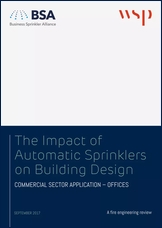The impact of automatic sprinklers on building design
The Impact of Automatic Sprinklers on Building Design: A fire engineering review, is an independent report produced by WSP, sponsored by the Business Sprinkler Alliance (BSA). It was published in September 2017.
The report aims to raise awareness of the beneficial impact of automatic sprinkler systems, and provides those involved in the design and construction supply chain with useful information about design implications. It gives the reader an appreciation of whether the inclusion of automatic sprinklers for a particular scheme is worthy of further consideration.
Automatic sprinkler systems extinguish or control fires by discharging water locally. Sprinkler systems consists of water supply (tank, pump and valves) and sprinkler installation (pipes and heads). Detection is handled mechanically by heat sensitive elements that can be constructed from soldered links or glass bulbs containing oil based liquids. The thermal element holds in place a plug which prevents water from flowing from the sprinkler head. The thermal elements respond to localised heating which releases the plug and allows water to flow.
Key facts about operation include:
- Automatic sprinklers will typically only operate in areas where fire is present allowing adjacent rooms or areas to remain unaffected.
- Discharge in the presence of fire is extremely reliable (98 to 99.8%) and discharge in the absence of fire is rare.
- Sprinklers have an 80-95% probability of being successful.
- Generally cost and design complexity increases with fire risk.
- Systems can be designed to conceal pipes, and the availability of decorative sprinkler heads allows them to be matched with the interior of the space.
The installation of an automatic sprinkler system can reduce the risk to life and the degree of damage caused in a fire event. As a result, it may be possible to reduce other fire protection measures.
The report focuses on the commercial and design impacts of automatic sprinklers rather than fire safety, exploring the ways automatic sprinklers can add value to building design, including:
- Net capital cost savings.
- Increasing the net internal area / building efficiency.
- Improving design flexibility and creating architectural freedom.
- Reducing the construction programme and/or simplifying site works.
Automatic sprinklers can permit:
- Larger compartment sizes.
- Reduced structural fire protection requirements.
- Increased travel distances leading to possible design freedoms such as the removal of stairs.
- Reduction in fire-fighting shafts.
- Reduced circulation areas leading to increased useable area.
The report supports the view that automatic sprinklers should be considered early in the design process and dispels myths about cost and design freedom. It provides an introduction to sprinklers, an overview of design and operation, and considers areas of design impact, fire protection costs and commercial applications for offices.
The first section of the report discusses concessions allowed by standard fire safety guidance for a variety of building types if automatic sprinklers are incorporated. The second section provides a review of office building types and key objectives relevant to them.
[edit] Related articles on Designing Buildings
- Automatic fire sprinkler.
- Automatic fire sprinkler systems: A good practice guide.
- Business Sprinkler Alliance.
- Case study A for offices to show where automatic sprinklers have the greatest impact.
- Case study B for offices to show where automatic sprinklers have the greatest impact.
- Costs of water automatic sprinkler systems.
- Design benefits of automatic sprinkler systems granted under approved document B.
- Drenchers.
- Fire detection and alarm system.
- Fire detector.
- Fire in buildings.
- Fire protection engineering.
- Fire safety design.
- Making the case for sprinklers and dispelling myths.
- Overview of automatic sprinkler system design and operation.
- Sprinkler head.
- Sprinklers.
- Sprinkler systems explained: A guide to sprinkler installation standards and rules.
- The cost efficiency of different combinations of fire protection measures.
- Watermist systems for fire protection in domestic and residential buildings DG 534.
Featured articles and news
Construction Skills Mission Board launch sector drive
Newly formed government and industry collaboration set strategy for recruiting an additional 100,000 construction workers a year.
New Architects Code comes into effect in September 2025
ARB Architects Code of Conduct and Practice available with ongoing consultation regarding guidance.
Welsh Skills Body (Medr) launches ambitious plan
The new skills body brings together funding and regulation of tertiary education and research for the devolved nation.
Paul Gandy FCIOB announced as next CIOB President
Former Tilbury Douglas CEO takes helm.
UK Infrastructure: A 10 Year Strategy. In brief with reactions
With the National Infrastructure and Service Transformation Authority (NISTA).
Ebenezer Howard: inventor of the garden city. Book review.
The Grenfell Tower fire, eight years on
A time to pause and reflect as Dubai tower block fire reported just before anniversary.
Airtightness Topic Guide BSRIA TG 27/2025
Explaining the basics of airtightness, what it is, why it's important, when it's required and how it's carried out.
Construction contract awards hit lowest point of 2025
Plummeting for second consecutive month, intensifying concerns for housing and infrastructure goals.
Understanding Mental Health in the Built Environment 2025
Examining the state of mental health in construction, shedding light on levels of stress, anxiety and depression.
The benefits of engaging with insulation manufacturers
When considering ground floor constructions.
Lighting Industry endorses Blueprint for Electrification
The Lighting Industry Association fully supports the ECA Blueprint as a timely, urgent call to action.
BSRIA Sentinel Clerk of Works Training Case Study
Strengthening expertise to enhance service delivery with integrated cutting-edge industry knowledge.
Impact report from the Supply Chain Sustainability School
Free sustainability skills, training and support delivered to thousands of UK companies to help cut carbon.
The Building Safety Forum at the Installershow 2025
With speakers confirmed for 24 June as part of Building Safety Week.
The UK’s largest air pollution campaign.
Future Homes Standard, now includes solar, but what else?
Will the new standard, due to in the Autumn, go far enough in terms of performance ?
BSRIA Briefing: Cleaner Air, Better tomorrow
A look back at issues relating to inside and outside air quality, discussed during the BSRIA briefing in 2023.
Restoring Abbotsford's hothouse
Bringing the writer Walter Scott's garden to life.
Reflections on the spending review with CIAT.



























